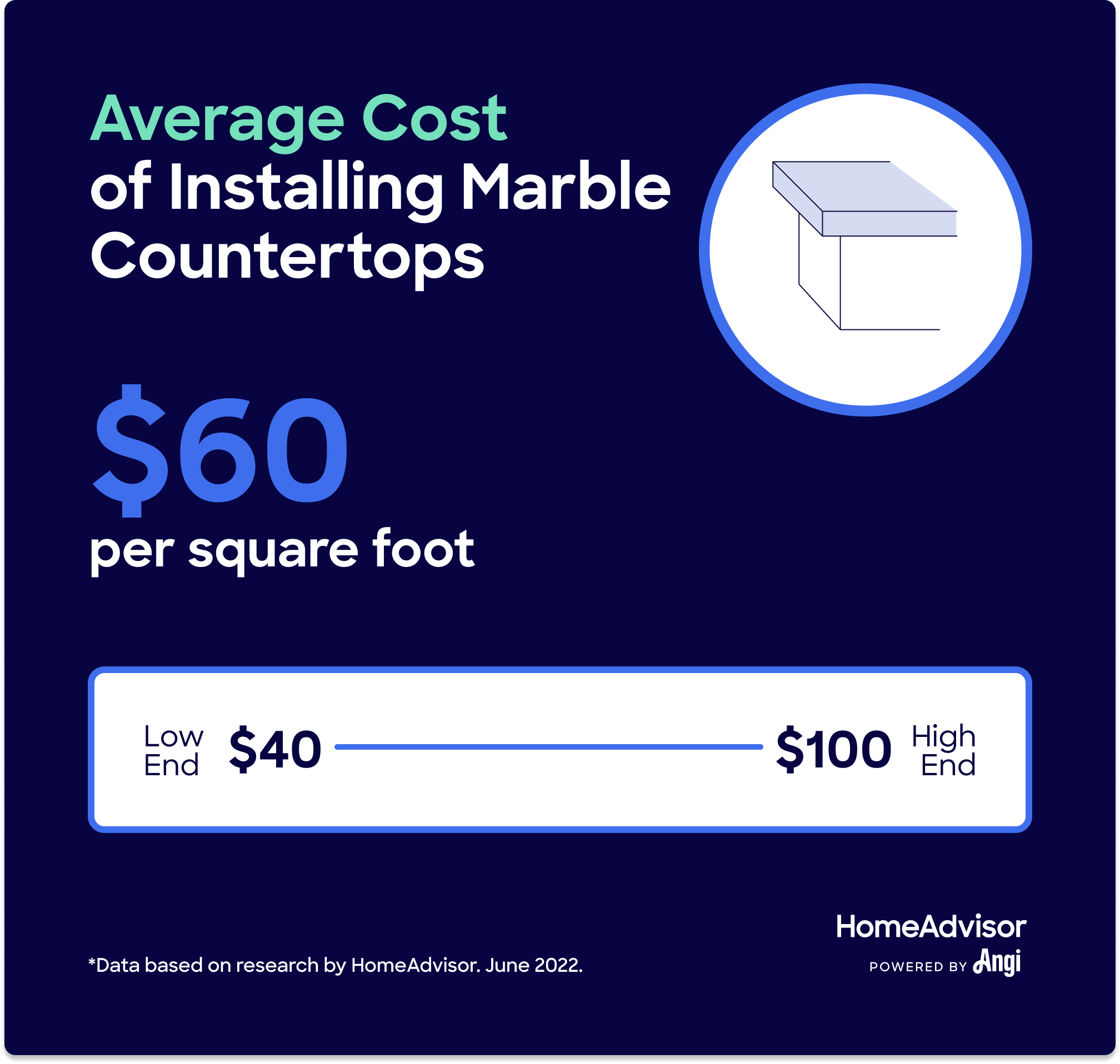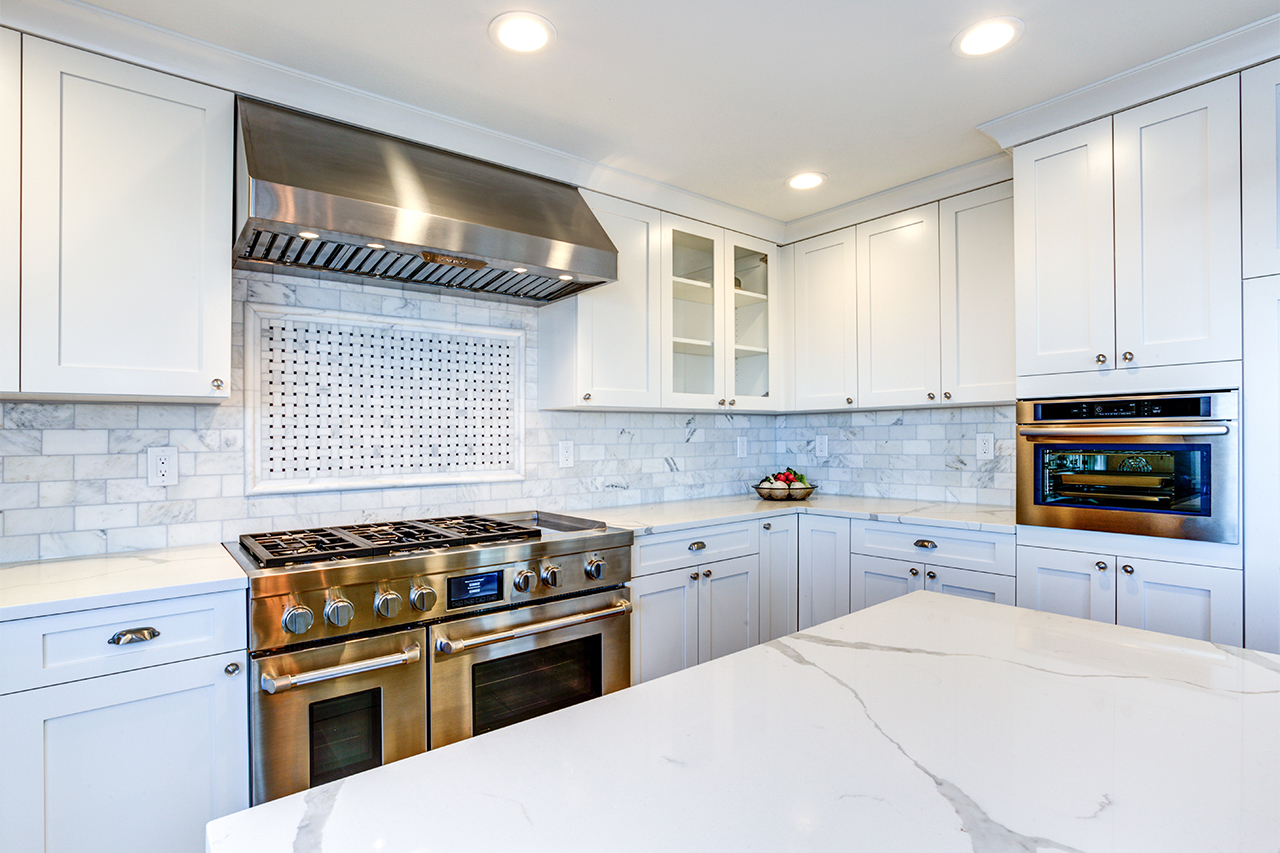How Much Are Marble Countertops?
Typical Range:
$2,000 - $5,000
Typical Range:
$2,000 - $5,000
Cost data is based on research by HomeAdvisor.
The cost of marble slab countertops range from $40 per square foot on the low end to $100 per square foot on the high end and are roughly $60 per square foot on average. Exactly how much you pay for this kind of addition depends on the type of marble you choose and the size of your countertop, as well as factors like edge treatments, disposal fees, and cost of labor.
Use this guide to understand what impacts the price of marble and how much it will cost to use this material for your countertops.
The average cost for marble slab countertops is $60 per square foot but can range from $40 to $100 per square foot. Material and installation costs depend on type, grade, size, transportation and more. For example, certain types of marble are rare, and therefore their cost is higher.
In general, marble slabs are more popular than marble tiles for countertops because they look cleaner and are easier to maintain—after all, fewer grout lines mean less scrubbing for you. Unfortunately, this additional luxury also means that marble slabs can be as much as 30% to 50% more expensive than tiles as a result.
Along with the type of marble and the style in which it’s cut, there are a handful of additional factors that also determine the final cost of this home addition.
In addition to choosing a type of marble, you also need to select an edge treatment commonly known as a well edge detail. While the most basic edge treatments—like the standard "bullnose" detail—don’t usually cost extra, you’ll pay between $10 and $40 for more ornate options, like beveled and French cove edges.
Unless you’re planning to DIY marble countertop installation, you’ll also have to factor in the cost of hiring a pro to do it for you. The cost of countertop installation like this is usually $35 to $45 per hour and, because projects typically take around 10 hours, that means you’ll pay roughly $350 to $450 for the whole service.
“Since the slabs are very heavy, a crew of between two to five people will need to carry the slab during the installation,” says Ezra Laniado, Angi Expert Review Board member and owner of Landmark Construction & Development Group, Inc. “During fabrication, they usually utilize a forklift with a special modified extension used to carry stone slabs. Because of the amount of strength, specialized tooling, and heavy machinery needed to fabricate a stone countertop, most fabricators charge by the square foot.”
All marble is graded on a scale of A to D, with A having the least amount of blemishes or damages and D having the most. You can find out a lot about a piece of marble simply by knowing what grade it is, including how much you can expect to pay. Here’s a quick breakdown for understanding more at a glance.
A: Has the least amount of flaws, little-to-no damage from shipping, subtle colors, and minimal veining. Typically costs the most.
B: Contains minor flaws like pitting and fissures (or when marble appears blotchy or cracked).
C: Features both minor flaws like pitting and fissures as well as major flaws like large cracks or chipping that will need to be professionally repaired.
D: Is somewhat or very damaged and features a lot of bright colors, dark veins, and both minor and major flaws. Usually the least expensive option.
The cost of removing an old countertop is another thing to consider when deciding to install a new one. Removal and disposal services can cost anywhere from $100 to $800 for this kind of project.
The type of marble that you choose is what will have the biggest impact on your final bill. Some varieties cost as little as $12 per square foot, and others as much as $180 per square foot. Find out what you can expect to pay for the most common marble varieties, plus a bit about what makes each option special, below.
| Type | Per Square Foot |
|---|---|
| Carrara | $40 |
| Calacatta | $180 |
| Statuario | $50 |
| Danby | $80 |
| Cultured | $65 |
| Makrana | $12 |
| Black / Travertine | $75 |
| Pink | $25 |
Carrara is the most common type of marble, making it the most affordable and most widely available. This type costs roughly $40 per square foot on average. Carrara is a white or blue-gray stone with soft gray veins and sometimes accents of gold. It is porous and will need to be chemically treated before being installed in spaces with plumbing, like kitchens or bathrooms.
This marble is known for being the most expensive variety and is typically sold for about $180 per square foot. It has a noticeable contrast between a white base and dark gray veins. It's also known for its brown and gold undertones. Calacatta is moderately porous and requires chemical treatment to make it appropriate for kitchen or bathroom use.
Although this marble variety is considered a precious marble in Italy, it’s not hard to purchase at a reasonable price. On average, this option costs $50 per square foot, and features iridescent gold and gray veins. Statuario is another example of a porous material that requires chemical treatment to make it appropriate for your kitchen or bathroom.
This type of stone costs around $80 per square foot. It looks very similar to marbles found in Italy but is often much denser. The coloring varies from pure white with gray veins to eggshell white and golden-brown veins. This stone also requires chemical treatment to seal it from water but is much less porous than its Italian counterparts.
Cultured marble is a manufactured stone substitute that is made in molds and is composed of stones, pigments, and resins. The cost of a cultured counter or floor option varies across manufacturers but is often much less expensive than natural marble. You can expect to pay $65 per square foot on average for this option.
This type of artificial marble is also great for bathrooms and kitchen surfaces because its surface is naturally non-porous and doesn’t need to be chemically treated the way that many types of natural marble do.
The average cost of this type is $12 per square foot. Makrana is known for being high quality and often does not need chemicals to reinforce the finish of the marble. This stone is milky white, often with rich gray or brown veins.
Makrana is used in many sculptures as well as lining walls of museums and mausoleums such as the Taj Mahal. It’s suitable for kitchen surfaces as well as bathrooms because it is not as porous as other types.
The average cost for this type is $75 per square foot. Also known as Travertine, this stone comes from different parts of Spain. Although it’s commonly used in bathrooms and kitchens, it does need to be chemically treated before installation to prevent water damage and scratching.
The average cost for this rose-hued stone is about $25 per square foot. It is more porous than the black version but can still be used in bathrooms and kitchens. It often has a pink base color with deep red veins, as well as golden or brown tones. This type is sometimes difficult to find and may require special ordering.
Aside from being the noted favorite of so many luxury abodes, marble comes with a handful of great benefits that aren’t so obvious, too.
Cut from the earth, marble is old as time and built to withstand the elements. It’s less resistant to scratching and water damage than other countertop types, especially if chemically treated before installation, and is relatively easy to repair when damaged.
Marble is beloved for kitchen countertops because it’s extremely resistant to heat, making it ideal for all kinds of culinary purposes. It will stay cold when used to roll out chilled pie dough, and it won’t crack under the heat of a saucepan straight from the stove.
Compared to other countertop options, marble is not as expensive as you would expect it to be. Butcher’s Block, for example, is $100 per square foot on average, which is much more than the average $60 per square foot that marble typically costs.
Because marble is so resistant to damage, it can live through generations with proper maintenance and regular care.
Although marble may seem like a luxury countertop material with a high price point to reflect that, it’s actually not as expensive as certain alternatives. Find out which options cost more or less in the table below.
| Concrete Countertop Costs | $5,000 – $10,000 |
| Buther Block Countertop Costs | $1,200 – $15,000 |
| Caesarstone Countertop Prices | $3,500 – $5,000 |
| Cost to Install Granite Countertops | $2,000 – $4,500 |
| Laminate Countertop Prices | $800 – $1,650 |
| Cost to Install Quartz Countertops | $1,500 – $12,000 |
| Silestone Countertop Installation Costs | $1,550 – $4,800 |
| Soapstone Counter Costs | $2,700 – $4,200 |
Calacatta is the most expensive type at $180 per square foot. This is because of its rarity. It is only found in one quarry, so its supply is very limited.
Solid surface is a type of countertop material that uses a mix of resins, pigments, and minerals to create a stone-like surface. These types of surfaces are often customizable, which means they can range in price from low to high. Engineered stone counters are often made of a mixture of quartz and resin. Marble is not man-made. It is a naturally occurring stone that is quarried and then custom fit to your kitchen or bath needs. It’s possible that the presence of manufactured, cultured marbles are responsible for the confusion.
The best type of marble for kitchen and bathroom counters is cultured. Though it is not the same as naturally occurring marble stone, it looks exactly like the real thing and is completely non-porous. This means that bacteria and stains will not grow because of a humid environment.
By upgrading aspects of your kitchen and bathroom to marble, such as countertops, floors, cabinets, and backsplashes, you can expect a near 75% resale ROI.
The prices vary across different types of material but, on average, granite installations cost about $3,500. Quartz installation costs around $8,000. Marble installation runs most homeowners about $3,000.

